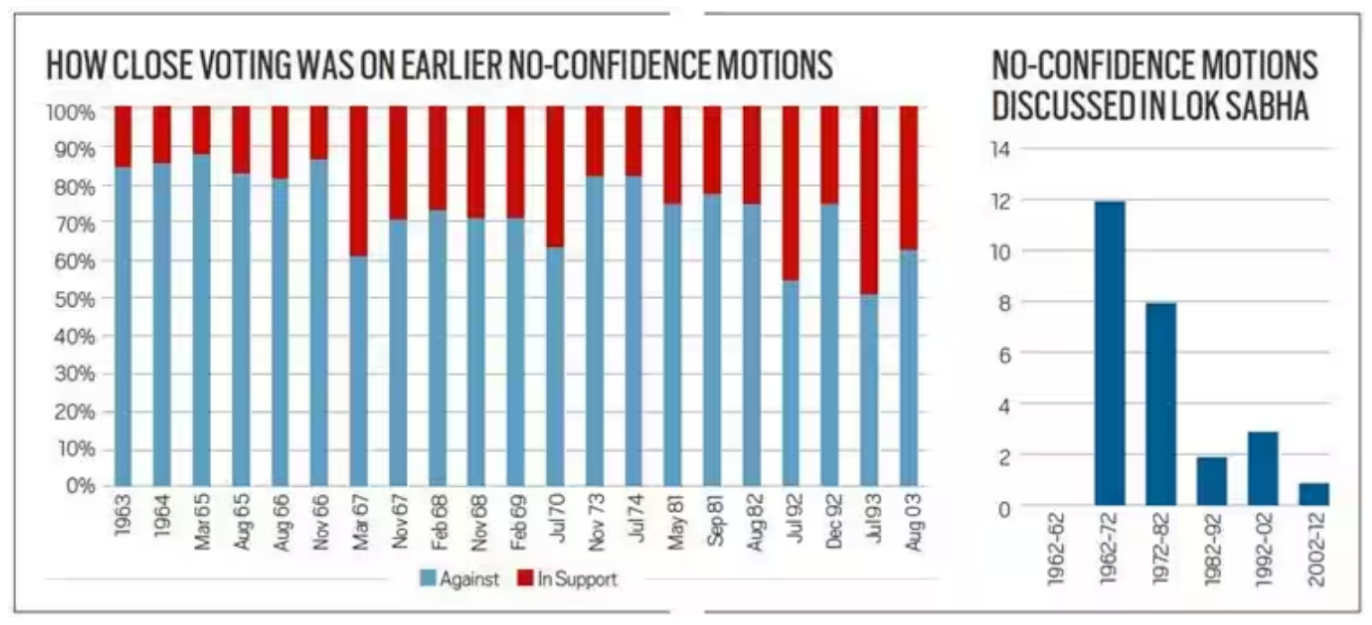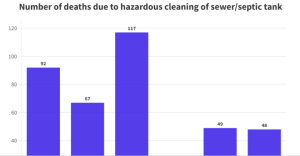Context:
The International Monetary Fund has raised its forecast for global growth this year in the July update of its World Economic Outlook.
Globally:

India’s Growth Projection:
Other Growth Projections for India:
| Organisation | India’s GDP Growth Forecast (%) | Reason/Comment |
| Asian Development Bank (ADB) | 6.4% | Retained forecast due to recovery in consumption demand in both rural and urban areas, but cautioned about subdued exports due to the global slowdown |
| Fitch (Global Rating Agency) | 6.3% | Raised forecast from 6% (predicted in March) to 6.3% due to improved economic conditions |
| Additional Information:
About International Monetary Fund (IMF):
|
News Source: The Indian Express
Context:
Recently, the Lok Sabha Speaker accepted a no confidence motion moved by the Opposition against the Government.
 Image Credits: Indian Express
Image Credits: Indian Express
About No Confidence Motion:
Instances of No-Confidence Motion:
| Year | Government of Day |
| 1990 |
|
| 1997 |
|
| 1999 |
|
Significance:
News Source: Times of India
Context:
About National Coal Index (NCI):
Additional Information:
| Characteristics | Non-Coking / Thermal/ Steam Coal | Coking / Metallurgical Coal |
|
|
|
|
|
|
|
|
|
News Source: Livemint
| Probable Mains Question
Q. What are the causes and consequences of manual scavenging in India? How can the government and the society eradicate this inhuman practice and rehabilitate the manual scavengers? |
Context: Recently, the Union Ministry of Social Justice and Empowerment revealed that only 508 districts out of the total 766 districts in the country have declared themselves manual-scavenging free.
More about the News:
 Under the Prohibition of Employment as Manual Scavengers and Rehabilitation Act, 2013, manual scavenging is banned in the country and there is a requirement of the formation of state safai karamchari commission, state monitoring committees and district vigilance committees.
Under the Prohibition of Employment as Manual Scavengers and Rehabilitation Act, 2013, manual scavenging is banned in the country and there is a requirement of the formation of state safai karamchari commission, state monitoring committees and district vigilance committees.About Manual Scavengers:
Interventions to Prevent Manual Scavenging in India:
Challenges in Eliminating the Menace of Manual Scavenging in India:
Way Forward:
| Additional Information:
“National Action for Mechanized Sanitation Ecosystem” (NAMASTE) Scheme”
National Commission for Safai Karamcharis (NCSK):
|
News Source: The Hindu
Context:
| Probable Question:
Q. Critically examine the Forest (Conservation) Amendment Bill 2023 passed recently. (250 words) |
About the News:
Need For Amendment bill:
Features of the Bill:
Redefining the ambit of “non-forest purpose” exemptions:
3. Power to issue directions:
4. Insertion of Preamble:
Significance of bill:
Issues with the bill:
Conclusion:
| Additional Information:
Forest Cover:
Status in India:
|
News Source: PIB
Context:
Recently, ‘India AI,’ and Meta India signed a memorandum of understanding (MoU) to promote collaboration in the field of Artificial Intelligence (AI) and emerging technologies.
MoU Between ‘India AI’ and Meta India:
Significance:
| Additional Information:
About INDIA AI:
|
News Source: PIB
Context:
Recently, the Minister of Earth Sciences provided information on the ACROSS scheme in Lok Sabha.
About ACROSS Scheme:
| Progress under ACROSS Scheme | Details |
| Advanced Weather Prediction Models |
|
| Air Quality Early Warning System |
|
| Enhanced Infrastructure |
|
| Meteorological Data Receiving & Processing |
|
| Lightning Location Network |
|
| Earth System Model (ESM) |
|
News Source: PIB
Context:
Recently, the Indian Computer Emergency Response Team (CERT-In) issued “Guidelines on Information Security Practices” for government entities for a safe and trusted Internet.
About: Guidelines on Information Security Practices: CERT-In
| Additional Information:
About CERT-In
|
News Source: Times of India
| DESI Initiative |
|
| Fast Radio Bursts (FRBs): |
|
<div class="new-fform">
</div>
